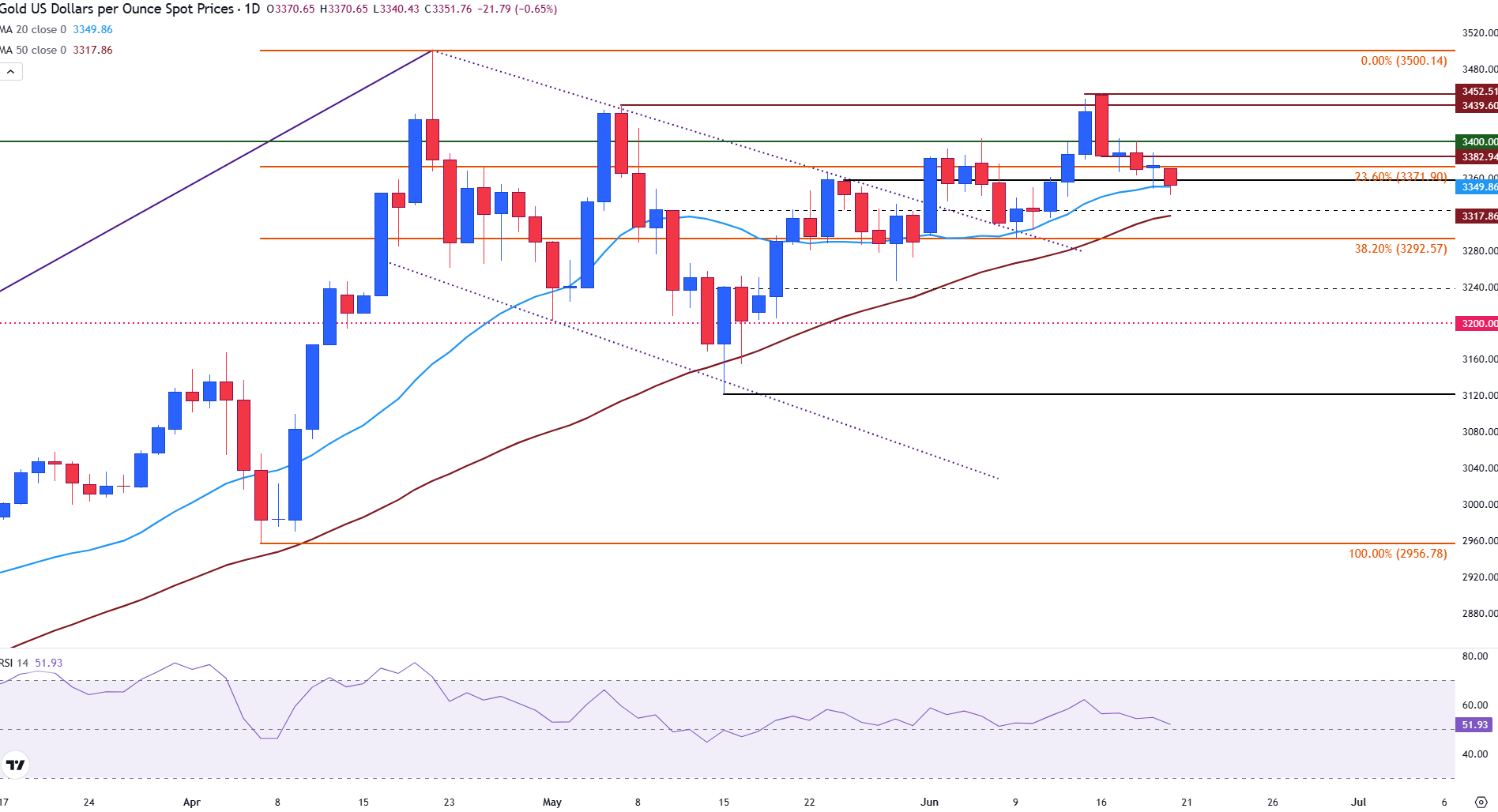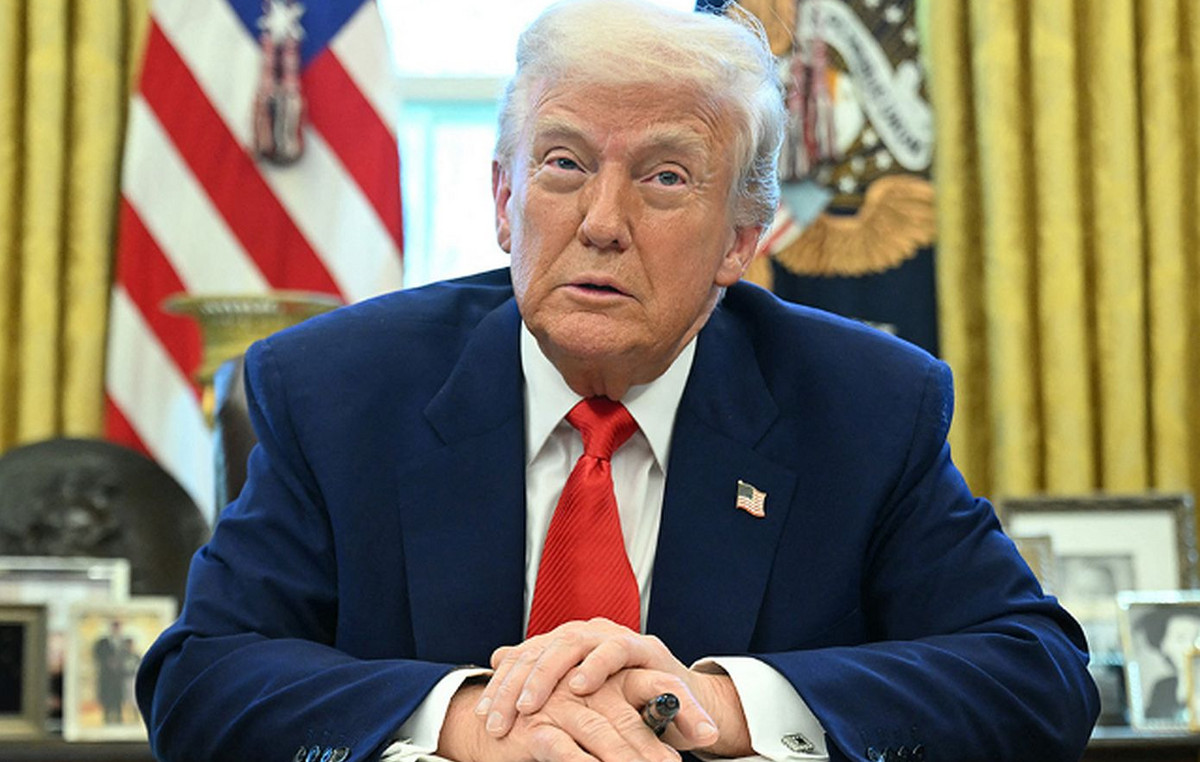- Gold is still highly sensitive to macro and geopolitical developments, with all eyes in the Israel-Iran conflict.
- The US dollar has erratic movements while operators weigh the expectations of interest rates in the face of the demand for safe refuge.
- The Xau/USD advances cautiously after President Trump announced a two -week period for his decision about Iran, limiting gold falls while investors expect the next great movement.
Gold (Xau/USD) weakens on Friday, quoting around $ 3,355 at the time of writing, since the yellow metal extends its setback from the maximum weekly about $ 3,452 registered on Monday.
However, the broader macro background still favors gold in the medium term, with the continuous demand of the central banks and the persistent geopolitical risks offering support.
This week, the Federal Reserve (FED), the European Central Bank (ECB) and the Bank of England (BOE) delivered cautious updates about monetary policy, underlining the risk that interest rates are maintained high for longer.
Even so, short -term recoil in the price of gold is driven by the fortress of the US dollar (USD), the firm yields of the treasure bonds and the reduced expectations of fed rates cuts, all of which have limited the attractiveness of the XAU/USD for now.
In addition, the US president, Trump, convened a second high -level meeting in the situation room on Thursday. Trump has given officials a two -week period to present viable military and diplomatic strategies.
The concerns are increasing, especially if the tensions interrupt the Ormuz Strait, a key energy point.
What moves the market today: gold is still in suspense while the US continues to drive the feeling
- The spokesmen of the Fed, the ECB and the BOE adopted a cautious tone throughout the week, with the gold weighing the implications of the yields increasing against their appeal as a safe refuge.
- The Fed maintained the rates in the range of 4.25%–4.50%, maintaining projections for two rates cuts later this year, although President Jerome Powell emphasized a data -dependent approach, citing persistent inflation and geopolitical uncertainty.
- The ECB made it clear that future cuts will depend on the progress in inflation data.
- Meanwhile, the BOE voted 6–3 to maintain its bank rate at 4.25%, with three members supporting a 25 basic points cut.
- Governor Andrew Bailey acknowledged that there is likely to produce rates reductions, but they will be “gradual and carefully considered.”
- The growing enriched uranium stock of Iran has revived global concerns, with the US and Israel reaffirming its opposition to a nuclearly armed Iran.
- The Russian Foreign Ministry warned that any US military intervention in Iran would be “extremely dangerous” and could lead to “unpredictable negative consequences.” These statements were issued Thursday by numerous news agencies.
- On Friday, Israeli defense minister Israel Katz declared that Iran’s Supreme Leader, Ayatolá Khamenei, “cannot continue to exist,” intensifying geopolitical tensions in the region.
- The markets are digesting the implications of that meeting, which supposedly included evaluations of the Fordow’s fortified nuclear installation of Iran and potential preventive attack options.
- The discussions are scheduled to include the underground nuclear site of Iran’s ForDow, suggesting the possibility of a direct participation of the USA.
- Approximately 20% of global oil and gas flows pass through the Ormuz Strait. An interruption could shoot oil and energy prices. This could feed inflation and press global central banks to maintain higher interest rates for longer to control uncontrolled price pressures.
Technical analysis: Gold goes back, testing the 20 -day SMA
The price action of the Xau/USD reflects a deeper setback from the recovery of April, with the bulls failing to recover the $ 3,400 barrier and the Momentum indicators leaning down.
The movement is part of a broader fibonacci setback from the minimum of April about 2,956 $ to the historical maximum of $ 3,500.
After staying close to the Fibonacci recoil level of 23.6% earlier this week, gold has broken below that support at $ 3,371, exposing lower back levels and weakening the technical perspective in the short term.
With the simple mobile average (SMA) of 20 days being tested at $ 3,350, the next target is located in the 50 -day SMA about $ 3,318, followed closely by the fibonacci setback of 38.2% in $ 3,292.
These levels represent the first important test of the durability of recovery. A rupture below that area could expose a horizontal support about $ 3,200, which supported multiple minimums in April and May.
The upward levels to be monitored include the fibonacci setback of 23.6% in $ 3,371, which now acts as resistance, and $ 3,400, a key psychological barrier.

Above that level, gold faces the maximum after the break of $ 3,452, both of which rejected recent bullish attempts.
Only a sustained closure above these levels would relive the bullish bias and reopen a path to the re-evaluation of the historical maximum of $ 3,500.
The relative force index indicator (RSI) prints in 52 in the daily chart, gradually sliding down and indicating a decrease in purchase pressure and bullish momentum.
Although it is not yet in over -sales territory, the indicator suggests that buyers are going back, leaving gold vulnerable to deeper setbacks.
FAQS GOLD
Gold has played a fundamental role in the history of mankind, since it has been widely used as a deposit of value and a half of exchange. At present, apart from its brightness and use for jewelry, precious metal is considered an active refuge, which means that it is considered a good investment in turbulent times. Gold is also considered a coverage against inflation and depreciation of currencies, since it does not depend on any specific issuer or government.
Central banks are the greatest gold holders. In their objective of supporting their currencies in turbulent times, central banks tend to diversify their reserves and buy gold to improve the perception of strength of the economy and currency. High gold reserves can be a source of trust for the solvency of a country. Central banks added 1,136 tons of gold worth 70,000 million to their reservations in 2022, according to data from the World Gold Council. It is the largest annual purchase since there are records. The central banks of emerging economies such as China, India and Türkiye are rapidly increasing their gold reserves.
Gold has a reverse correlation with the US dollar and US Treasury bonds, which are the main reserve and shelter assets. When the dollar depreciates, the price of gold tends to rise, which allows investors and central banks to diversify their assets in turbulent times. Gold is also inversely correlated with risk assets. A rebound in the stock market tends to weaken the price of gold, while mass sales in higher risk markets tend to favor precious metal.
The price of gold can move due to a wide range of factors. Geopolitical instability or fear of a deep recession can cause the price of gold to rise rapidly due to its condition of active refuge. As an asset without yield, the price of gold tends to rise when interest rates lower, while the money increases to the yellow metal. Even so, most movements depend on how the US dollar (USD) behaves, since the asset is quoted in dollars (Xau/USD). A strong dollar tends to keep the price of gold controlled, while a weakest dollar probably thrusts gold prices.
Source: Fx Street
I am Joshua Winder, a senior-level journalist and editor at World Stock Market. I specialize in covering news related to the stock market and economic trends. With more than 8 years of experience in this field, I have become an expert in financial reporting.







